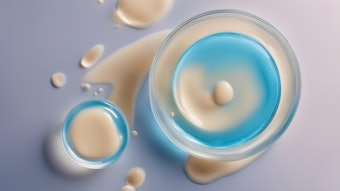In 2001, Japanese researchers reported that after the age of 40, some individuals develop a malodor known as “aging odor,” attributed to the presence of unsaturated C9, 2-nonenal. George Preti, PhD, a member of Monell Chemical Senses Center and an adjunct professor of dermatology at the University of Pennsylvania School of Medicine, was interested by this report and began to conduct research of his own. His work1 analyzed the volatile organic compounds (VOCs) emitted from human skin; however, instead of sampling VOCs from the axillae (underarms) considered the primary source of human body odor, his team sampled from non-axillary skin, including the upper back and forearms, that also emits volatile metabolites.
Sampling VOCs from Skin
For Preti’s study, 25 participants, 13 male and 12 female, showered and bathed with a provided, fragrance-free liquid soap/shampoo for 7–10 days prior to being tested. “We wanted to lessen the influence of exogenous sources of VOCs from consumer products,” said Preti, who added that test subjects were also asked not to use fragrance or deodorant during this time.
Before sampling the VOC content, researchers had the test subjects climb stairs or run on a treadmill to generate sweat. According to Preti, a funnel approximately 10 in. in diameter for the back, and 6 in. for the forearm, was then placed over the skin.
“The funnel is used to concentrate the space air tested into a smaller area,” said Preti. A solid phase microextraction (SPME) fiber was then placed in the funnel, close to the skin, for 30 min. and this was repeated on the opposite side of the back and the forearm. Samples were then inserted into a GC/MS apparatus hot injector for 1 min to emit the VOCs collected in the fiber. The air VOC content also was tested with a SPME fiber to rule out VOCs in the surrounding air.
“Heavier materials are not likely to come off the skin in the vapor phase,” said Preti. Therefore, the researchers collected a solvent extraction of skin secretions.
“Vapor phase chemicals are lighter and smaller and more likely to cause odor,” added Preti, who noted that it was necessary to take samples from the skin as well. The extracts from the skin’s surface were produced by applying an ethanol/hexane mixture to the subject’s forearm that was then pipetted into a cylinder pressed against the skin.
The SPME and the solvent samples both were analyzed by age and gender. The groups included young male (≤ 40), older male (> 40), young female (≤ 40) and older female (>40). Although both samples were processed with the GC/MS apparatus, the solvent samples were also processed with a gas chromatograph fitted with flame photometric detection.
Age and VOC Content
VOCs found in the headspace of unfragranced soap and in the air of the room were subtracted from the results to determine the VOCs found in the skin. Of the 92 compounds found, 58 were detected in SPME samples, 49 were present in solvent extracts, and 15 were found in both. Preti and his team discovered that many of the compounds came from exogenous sources and that, although subjects were separated by age, no significant differences in the relative amounts of compounds between men and women were noted.
“The compounds found in the subjects across age ranges were similar. Certain compounds were present in greater amounts in older individuals and [others] were in greater quantities in younger individuals,” explained Preti. Those compounds found in greater amounts in the older subset included dimethylsulphone, benzothiazole and nonanal, although not C9 aldehyde, 2-nonenal, suggesting the absence of an aging odor in some individuals. In addition, researchers found considerable exogenous VOCs derived from consumer products.
The Future of VOC Reseach
The VOC profiles of skin could have future applications, according to Preti. Using the same VOC method to study basal cell tumors, Preti’s team discovered a different chemical compound profile than for healthy control subjects. Dimethylsulphone, benzothiazole and nonanal were found to act as biomarkers of older age but these were not reported in the Japanese study. Their presence here could be attributed to regional differences.
Although the profiles contained the same general array of chemicals, the specific amounts differed. Preti and his team plan to characterize skin odor profiles associated with other forms of skin cancer, including squamous cell carcinoma and melanoma. “In the future, we will be able to diagnose skin cancer earlier with a VOC profile,” added Preti.
In addition to its role in skin cancer research, VOC profiling could lead to more effective antiaging skin care since it can determine what chemicals may build up in skin over time. Formulations might be developed to target the reduction of certain compounds or omit others due to their accumulation potential. According to Preti, a more in-depth study into what compounds are found in the body could lead to new developments.
References










